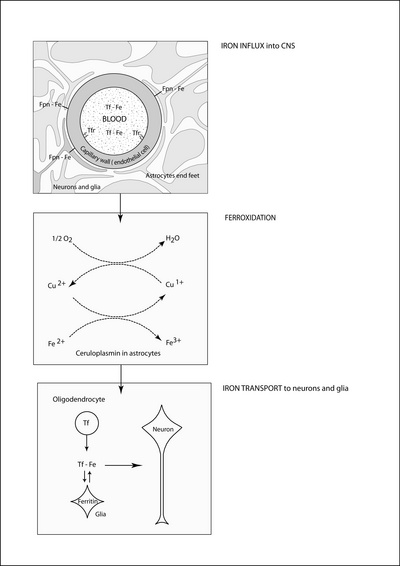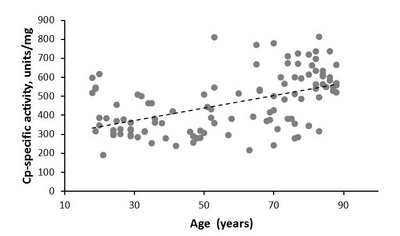10. tbl. 98. árg. 2012
Ceruloplasmin (Cp) and iron in connection with Parkinson's disease (PD) and Alzheimer's disease (AD)
Serúlóplasmín og járn. Tengsl við Alzheimersjúkdóm og Parkinsonsjúkdóm
Ceruloplasmin, a multi-copper oxidase with four active copper atoms, oxidizes Fe2+ to Fe3+ and concomittantly fully reduces oxygen to water. The oxygenation of iron is a requisite for transferrin transport of iron and keeping noxious Fe2+ low. In the central nervous system (CNS) Cp is mostly localized in end feet of astrocytes surrounding capillaries and attached by a glycosylphosphatidylinositol-anchor. In aceruloplasminaemia, a rare recessive hereditary disease, complete loss of Cp is accompanied by disorders of iron metabolism and lesions in CNS and outside. In PD Cp concentration and oxidative activity in serum are significantly lowered with iron deposits and lesions in substantia nigra and basal ganglia. Changes in Cp-genes might be causative in these disorders. By inducing neuromelanin synthesis Cp may protect neurons in substantia nigra. In AD Cp activity in serum, but not concentration, is significantly lowered. Changes in Cp-genes have not been verified in AD. Total amounts of iron are not increased in AD brains although iron deposits and cortical lesions are numerous. Total copper is significantly lowered in AD brains. This may result in defective synthesis of Cp and other copper enzymes. – In conclusion, the defective Cp activity, associated with iron disorders, is seemingly of importance in PD and also in AD with other copper enzyme defects possibly involved.
Johannesson T1, Kristinsson J1, Torsdottir G2, Snaedal J2
1The Department of Pharmacology and Toxicology, Medical Faculty, The University of Iceland, Reykjavík, 2Department of Geriatrics, Landspítali - The University Hospital of Iceland, Reykjavík.

Figure 1. A schematic drawing showing iron influx in the CNS (uppermost panel), ceruloplasmin (Cp) mediated iron oxidation in astrocytes (intermediate panel) and iron transport to neurons and glia (lowest panel). – Iron (Fe3+) loaded transferrin (Tf-Fe) in blood binds to its endothelial receptors (Tfr) in brain capillaries. The iron is discharged, reduced (Fe2+) and bound to the membrane-based iron carrier ferroportin (Fpn-Fe). Cp anchored to astrocytal end feet stabilizes Fe2+ on Fpn and oxidizes it to Fe3+ for Tf transport to neurons and ferritin glial stores.

Figure 2. Cp (ceruloplasmin) – specific activity with age in serum of 112 (51 females; 61 males) healthy individuals. The regression line shows a statistically significant increase in the specific activity with age (linear regression: P < 0.001).
